| COUNTY DURHAM - 3 |
|
Redmarshall South Church Stockton-on-Tees Staindrop Whitworth Winston-on-Tees <Durham City> <Durham County - 1> <Durham County - 2> |
| Redmarshall - St Cuthbert |
 |
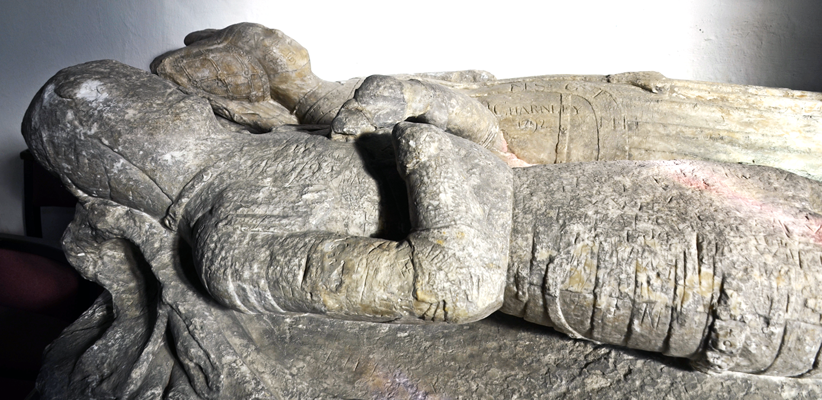 |
| Thomas Langton (1440) and his wife, Sibyl |
 |
South Church - St Andrew |
 |
 |
| Lady, stone. Late 14th century | Knight, oak. C. 1340 |
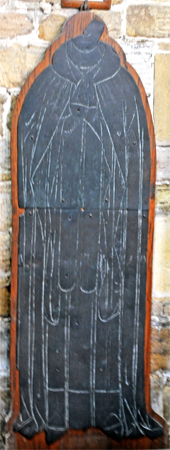 Priest, late 14th century 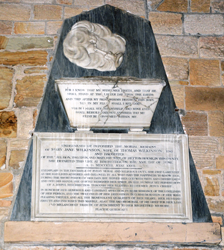 Mary Jane Wilkinson (Lyon) (1703) |
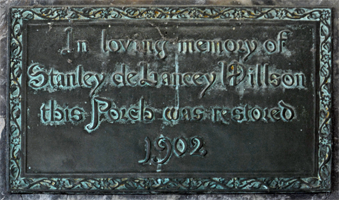 Stanley de Lancey Willson. 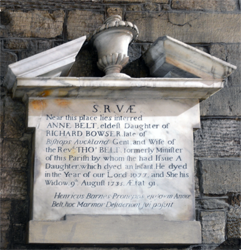 Anne Belt (Bowser) (1735) Widow of Tho' Belt minister who died in 1677  Ms Gartrude Wren (1637)  Cross and shears |
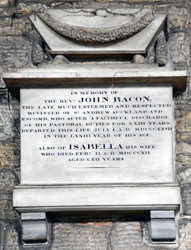 Rev John Bacon (1827) Minister of St Andrew Auckland and Escomb. Also his wife: Isabella (1812) 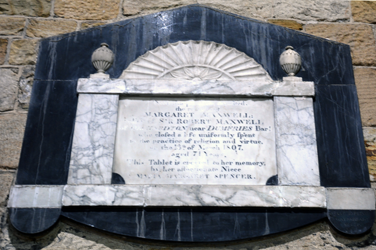 Margaret Maxwell (1807) 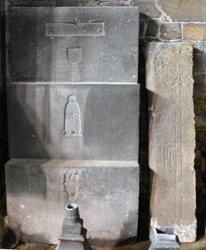 Reused brass matrices |
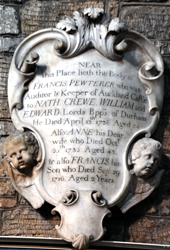 Francis Pewterer (1738); his wife, Anne (1732), and their son, Francis (1716) at 2. He was auditor and keeper at Auckland Castle to the Lords Bishops of Durham.  Lt Col William Glover (?)  Martha Dobson (1837) |
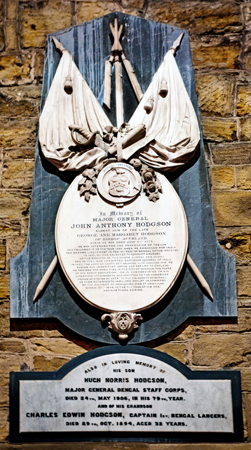 Mjr-Gen John Anthony Hodgson (1849) He died at Umrallah, Rohilound District, India, where he is buried; also his son, Mjr-Gen Hugh Norris Hodgson (1906); also his grandson, Cpt Charles Edwin Hodgson (1894) at 32. 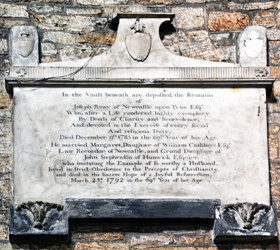 Joseph Reay (1783) and his wife, Margaret (Cuthbert) (1792) |
| Elizabeth Dinsdale (1907) Brass with floral border on black marble back |
| Edward Maltin DD Lord Bishop of Durham 1836-1856 'to whom a former east window in this church was erected by public subscription.' Brass with leaf lower border and arms top centre. |
| 'To the Glory of God and in memory of...' '...assistant curates of this church...' William George Selway (1891-1893), Henry Robert Norris (1898), Alfred Randolf Wilson (1898)., Philip Henry Page (1898-1902). Brass with vine leaf border and cross top centre, below which crossed quills. Below this is a plain separate brass: 'Also in memory of Charles Smith BA (1904-1907)' |
| Ernest Maximilien Charles, Marquis de Kerven de Limoelan BA. (1884) Headmaster of King James I Grammar School, Bishop Auckland |
 |
Stockton - on - Tees Parish Church |
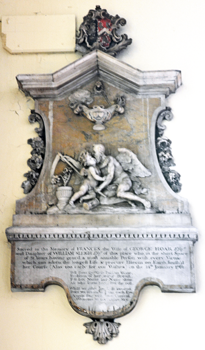 Frances Hoar (Sleigh) (1761) Old Father Time with scythe and hour glass is often represented on church monuments. But is the smaller figure the New Year. It looks rather like the Titan Cronos and one of his children; surely not. |
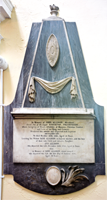 John Allison (1805), merchant; Lt- Col of the Loyal Stockton volunteers; his daughter, Ann (1790) aged 18; and his wife, Jane (1836) |
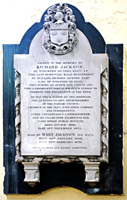 Richard Jackson JP (1875) Twice mayor. 22 years vicar's church warden. And his wife, Mary (1875) |
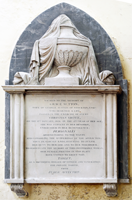 Grace Sutton (1814) |
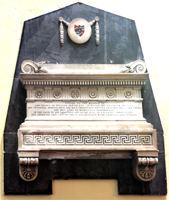 Ann Sleigh (1835) |
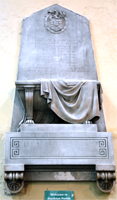 Lt Col William Sleigh |
|
|
||||||
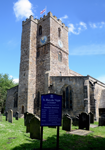 |
Staindrop - St Mary | |
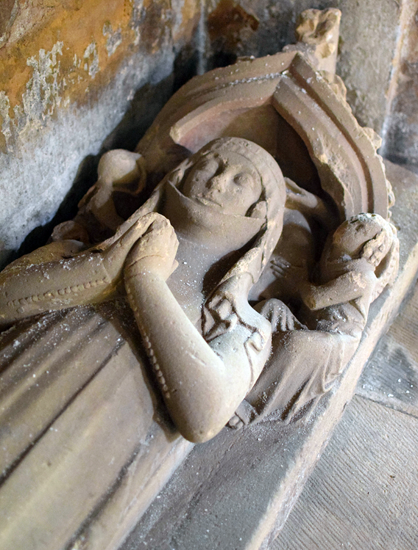 |
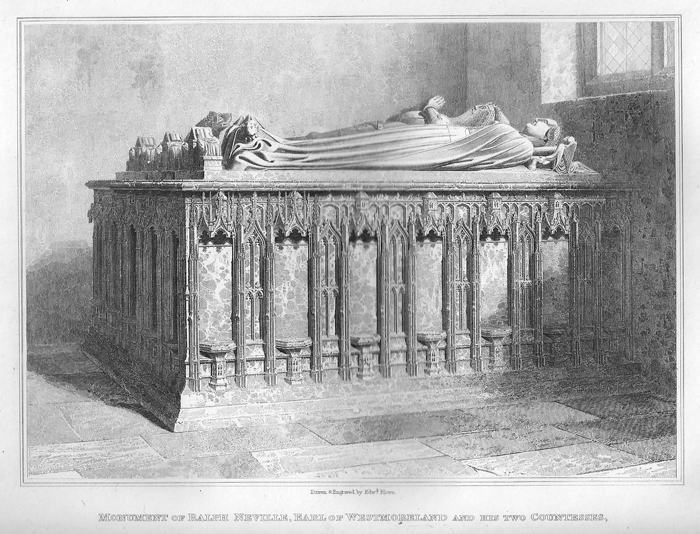 |
||
| Euphemia de Clavering (mid 14th) This effigy is in a recess in the south aisle; there is a second lady with a boy, also in a recess in this aisle, but 13th C. There is another lady - 13th century - on the floor between the two large tomb chests (see below). | Alabaster |
 |
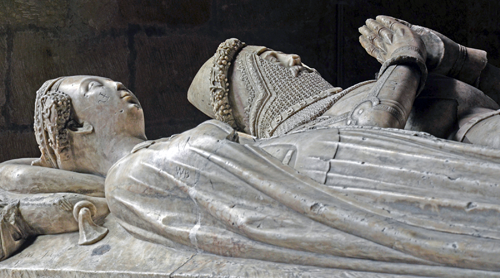  |
 |
|
| The Neville tomb showing the tomb chest; the weepers or angels are missing. In the foreground is 13th century lady referred to above. | |
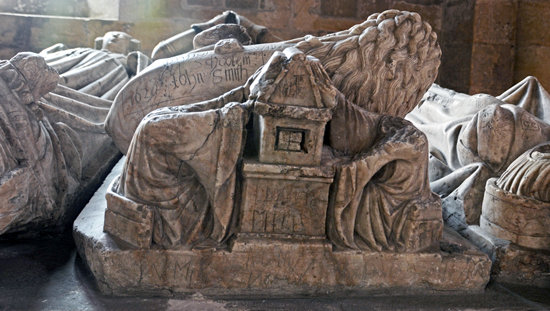 |
| It is difficult to see from the long shots exactly what the feet of the three effigies are resting on. They do follow the frequent arrangement of the ladies' feet resting on dogs and the knight's feet resting on a lion but the animals themselves each rest on a pair of seated monks reading at a double lectern. |
| A Tangled Web - A Simplified Who Was Who |
Ralph Neville, Earl of Westmoreland married, as his second wife, Joan Beaufort, daughter of John of Gaunt, himself a son of King Edward III. She was one of the four Beaufort children - she had three brothers - of John of Gaunt and his mistress, Kathryn Swynford; all of the four children were thus illegitimate, not that that worried anyone at all, except when it came to inheritance. John of Gaunt later married Kathryn and the Beauforts were made legitimate, not because of this subsequent marriage (that law did not arrive until 1926 and then with some restrictions) but by Act of Parliament. However, there was a proviso to this act: the Beaufort line was barred from the throne. Not that this worried anyone either: later the much married Lady Margaret Beaufort was to become mother of Henry VII (Tudor). Ralph and Joan had a number of descendants who were to make marks of varying degrees on history. However we will discuss just two of their children here. A genealogical table would be needed to understand all these complicated inter-relationships. Their son Richard Neville married Alice Montague, who was heiress to the Earldom of Salisbury, thus becoming Earl of Salisbury. Not that it did him a lot of good in the long term as he joined the Yorkist faction during the Wars of the Roses, and was beheaded after the Battle of Wakefield. His son, another Richard Neville, known to history as the Kingmaker, married Anne Beauchamp, heiress of the Earldom of Warwick, so becoming Earl of Warwick and as well Earl of Salisbury after his father's execution. He was initially a Yorkist but, because he felt he wasn't as influential as he would like to have been, swapped over to the Lancastrians who looked an easier option. Not a good move: he was killed at the foggy Battle of Barndet, trying to escape from the field. This Richard Neville had two daughters (actually three, one, Margaret, was illegitimate), Isabel and Anne, both of whom will reappear below. Another child of Ralph and Joan, this time was a girl, Cecily Neville known, rather delightfully, as the Rose of Raby, having been born in Raby Castle and, it is said, a girl of remarkable beauty. She married Richard, Duke of York, who was quite lucky to have inherited that title as his father was Richard, Earl of Cambridge, brother of Edward, 2nd Duke of York, and both sons of Edmund of Langley, 1st Duke of York, a son of King Edward III. Now Richard, Earl of Cambridge took part with others in the Southampton plot to depose Henry V - himself a grandson - but a legitimate one - of John of Gaunt, whom we have mentioned above - just before Henry was about to embark to France in his attempted conquest. The aim of plot was for Henry to be replaced not by Richard, Earl of Cambridge but by Edmund Mortimer, whose sister Anne Mortimer, Richard had married. The Mortimer family were descended from Lionel, Duke of Clarence, the 3rd son of Edward III but by the female line. However Edmund Mortimer had no wish to become king (not a secure job at the time)and reported the plot to King Henry; Richard, Earl of Cambridge and the other conspirators were promptly executed. Edward, 2nd Duke of York played no part in his brother's conspiracy and sailed to France with King Henry only to be killed at the Battle of Agincourt. He died childless and his nephew - son of the executed Richard, Earl of Cambridge - was curiously and, as it turned out, inadvisably - allowed to inherit the title. So Cecily, the Rose of Raby, was married to Richard, 3rd Duke of York who felt he had a better claim to the throne than did the rather useless King Henry VI, Henry V now having died young: he was after all descended from the third son (Lionel of Antwerp, Duke of Clarence) of Edward III, albeit via his mother and, as mentioned, via the female line anyway and from the fifth son (Edmund, Duke of York) via his father. The lines of the first and second son were extinct. A better claim he felt than the King who was only descended via the fourth son (John of Gaunt, Duke of Lancaster). A claim that led to the Wars of the Roses but to came to nothing as Richard was executed - like Richard Neville, Earl of Salisbury - after the Battle of Wakefield. But Richard and Cecily had three sons: Edward, Duke of York (who was to become Edward IV), George, Duke of Clarence (who was to be drowned in a butt of wine) and Richard, Duke of Gloucester (who was to become Richard III). Edward was captivated by and later married the lovely - and Lancastrian - widow Elizabeth Woodville but the estates and daughters of of the dead Richard Neville were shared out between the brothers, George marrying Isobel and Richard marrying Anne. To round off this tale that all of the sons of these marriages came to an untimely ends: Edward's two sons were the 'Princes in the Tower'; George's son, Edward, Earl of Warwick was imprisoned and later executed by Henry VII (allegedly on the grounds that he had attempted to escape from the Tower of London with the pretender Perkin Warbeck but it is also said that Henry had him executed at the request of Ferdinand and Isabella of Spain as a condition of their daughter, Katherine of Aragon marrying Henry's son, Arthur, the never to be future king; and Richard's son, Edward of Middleham, died young. Thus ended the male Yorkist line - but not the ladies! |
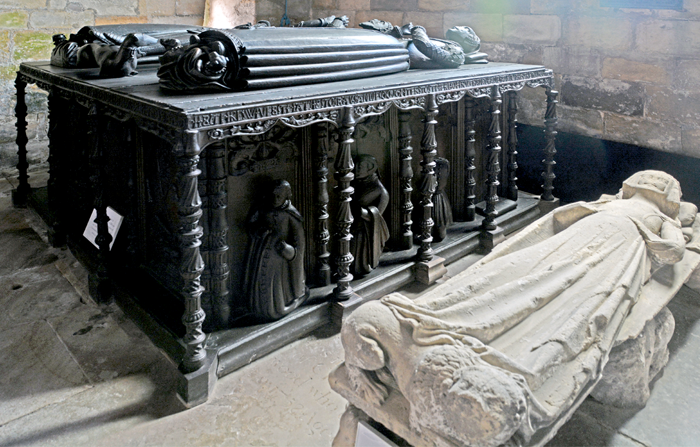 |
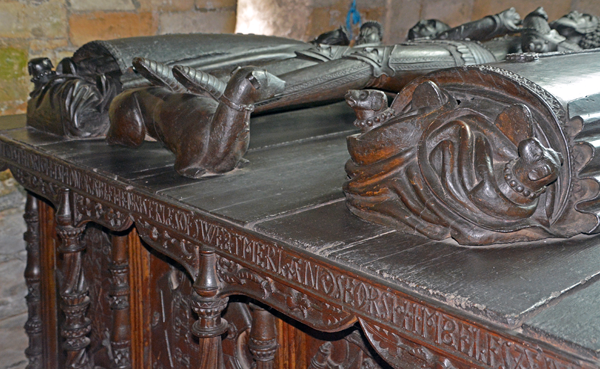 |
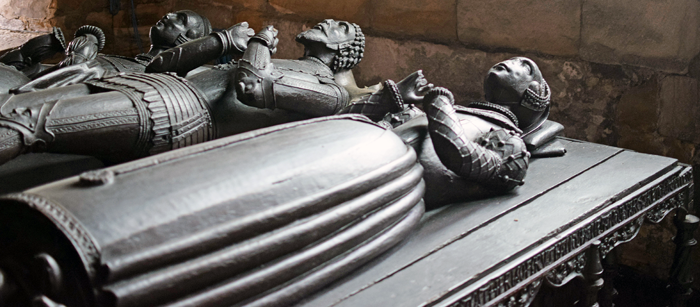 |
|
| Henry Neville, 5th
Earl of Westmoreland (1567) with his second and third
and wives, Jane (Cholmeley) and her sister
Margaret (Gascoigne) The monument was made of oak by John Tarbotons. It now appears black in most areas. Note that the feet are reating on a number of dogs. In the top left picture can be seen again the 13th century lady referred to above. |
|
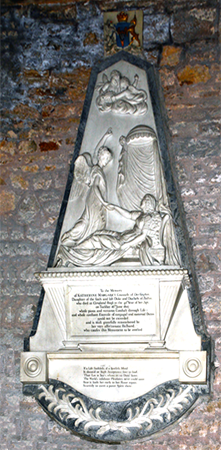 |
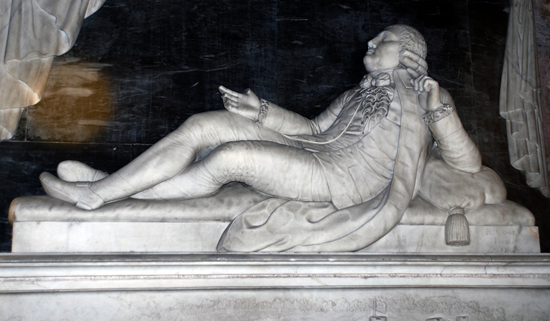 |
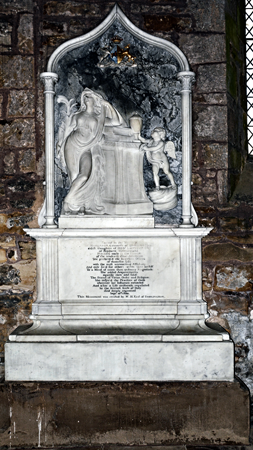 |
| Left:
Katharine Margaret, Countess of Darlington (1807) Above: Henry, 2nd Earl of Darlington (1792) Also shown below where a relief of Raby Castle, which he restores, can be seen Right: Margaret, Countess of Darlington (1800) All three of these monuments are by Robert Cooke of London |
 Above: Sophia, Duchess of Cleveland (1859) Right: see above Far right: General interior view of the church; some of the monuments shown elsewhere can be seen in the background. The wall monument in the forground is to Mary Lee (1812) Note: there is also a reference in Pevsner's County Durham to John Lee, Attorney-General (1793) with bust and books on a table and Mary Lee (1813) by Nollekens. I do not have a photograph of this monument but the Mary Lee to the far right died in 1912, was the widow of John Lee and the monument is signed by Nollekens. It is likely this is the same person and the date in Pevsner is an error. |
 |
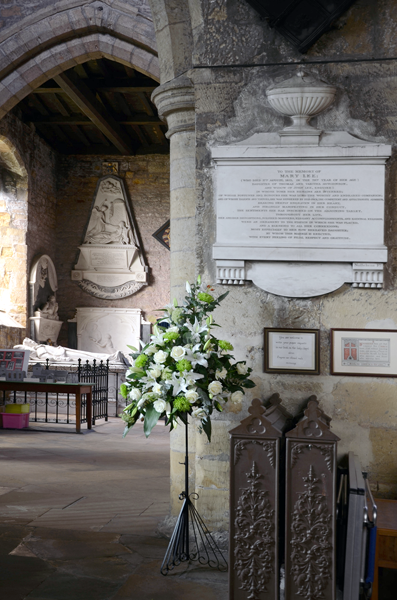 |
 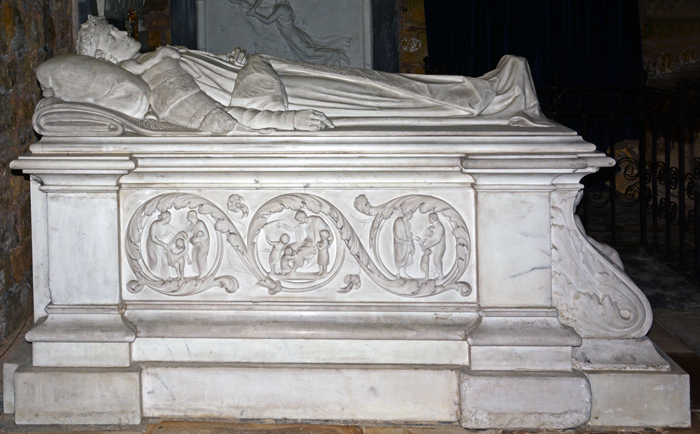 |
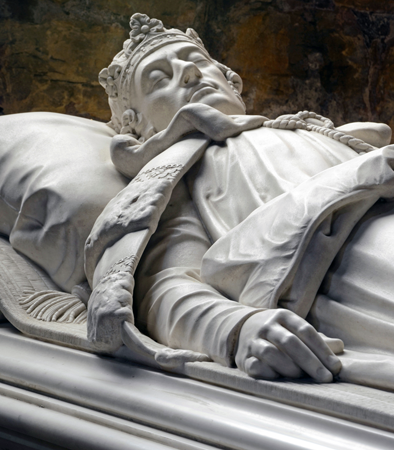 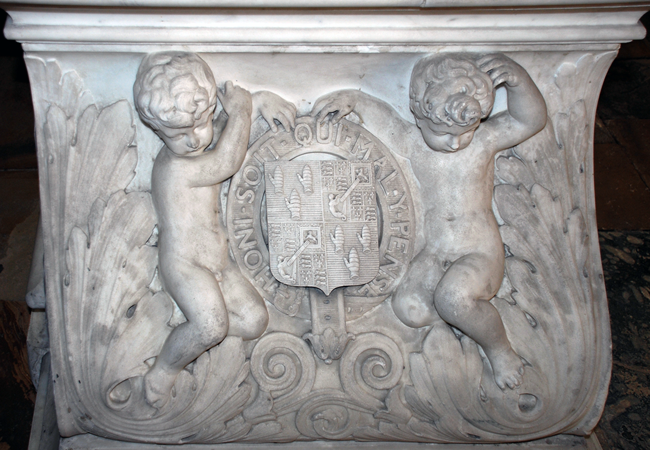 |
|
William Henry, 1st Duke of
Cleveland (1842) White marble by
Sir Richard Westmacott |
|
 |
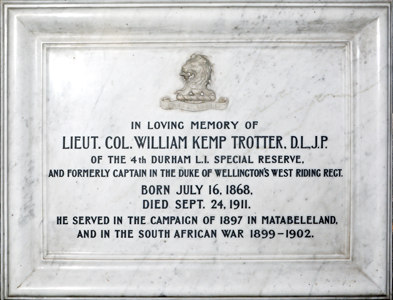 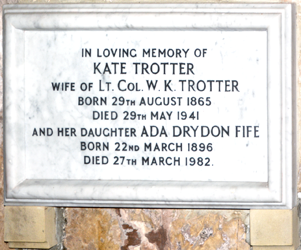 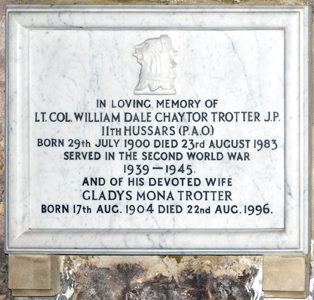 |
Above is a row of similar wall tablets to the Vane family; from left to right: 1) Henry de Vere Vane, 9th Baron Barnard (1918) and his wife, Catherine Sarah (1918). 2) Henry Cecil Vane, Cpt R.F.A (1918) Died at Rouen of illness contracted on service and buried ar St Sever Cemetery. 3) Ralph Frederick Vane, Cpt Durham Light Infantry (1928) To the right a series of similar monuments to the Trotter family; from top to bottom: 1) Lt Col William Kemp Trotter DL JP (1911) 4th Durham L I Special Reserve; formerly Cpt in the Duke of Wellington's West Riding Regt. 2) Kate Trotter (1941) wife of Lt Col W K Trotter; and her daughter Ada Drydon Fife (1982) 3) Lt Col William Dale Chaytor Trotter JP (1983) 11th Hussars; and his wife, Gladys Mona Trotter (1996) |
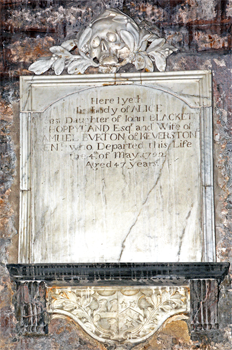 |
 |
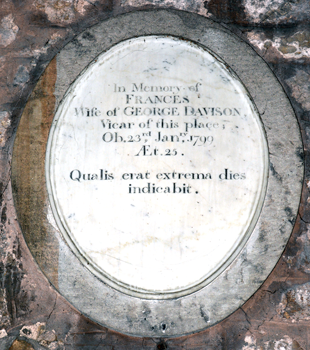 |
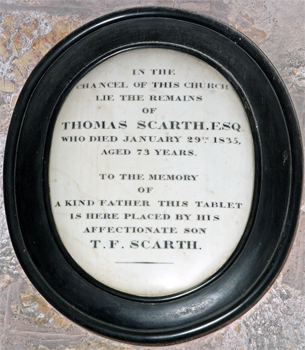 |
| Left:
Alice
Burton (Blackett) (1722) Above: Caroline, Duchess of Cleveland (1883) Right: Frances Davison (1799) The then Vicar's wife. Far right: Thomas Scarth (1835) |
 |
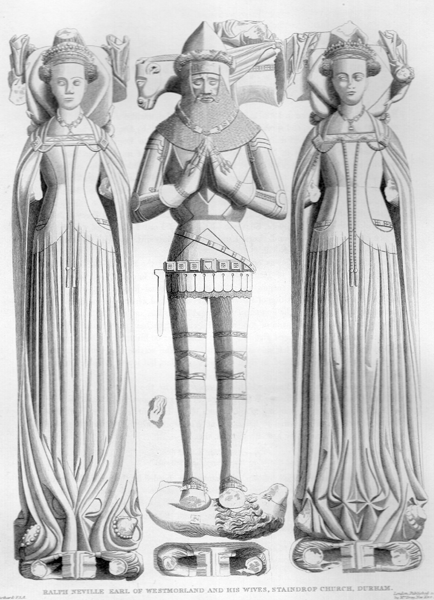 |
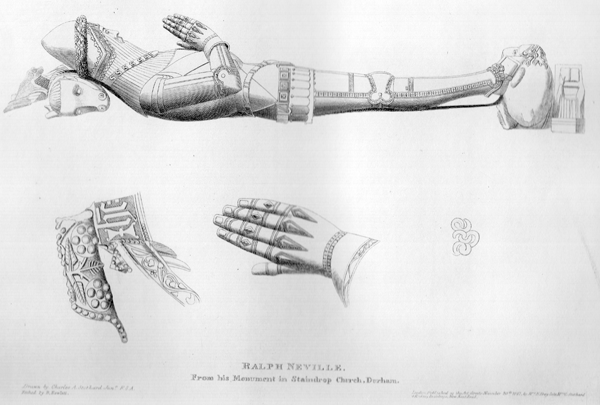 |
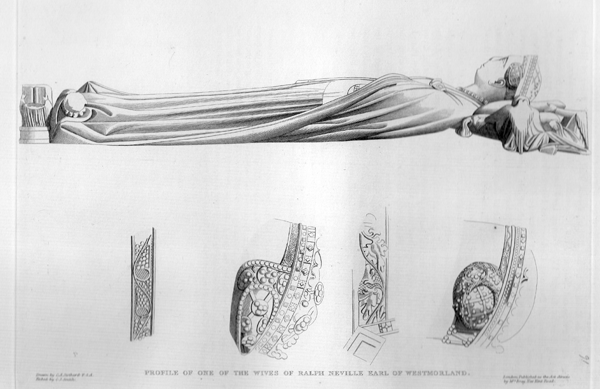 |
| Etchings by C A Stothard from
Staindrop Church: Top left: This is the 13th century lady, who is at the side of the 5th Earl's monument but has not been individually photographed. Top right and bottom: Ralph Neville, Earl of Westmoreland (1425) and two wives, Margaret (Stafford) and Joan (Beaufort). |
|
| Whitworth |
| There appears to be no dedication |
 |
  |
 |
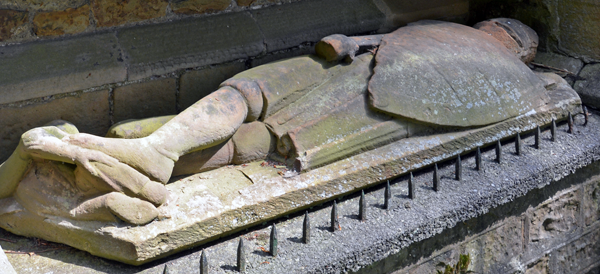 |
| Two effigies outside the church. The knight is late 13th century and of sandstone. The other is very worn and may be a lady. I also include Stothard's two etching of this interesting effigy. | |
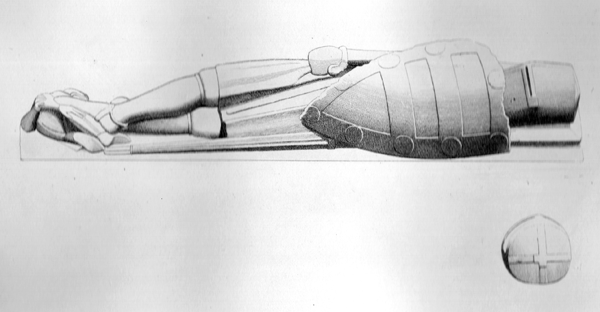 |
 |
Winston-on-Tees - St Andrew |
 |
 |
 |
 ALICE BREAKS DYED YE 21 OF OCTOBER 1724 AGED 68 |
| John Bourne (1855) and his wife who is not named, née (Temple)(1807) | Rob P Lancaster (1706) Rector and his wife, Sophia L Lancaster (1685) | Note the sword and birds |
| Other Monuments |
| Peneople Osbourne (Lowe) who married Thomas Harrison (1869). White tablet with cross in the gable and apron; black backing. |
| Margaret Dodds (1860) As above but with no cross |